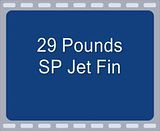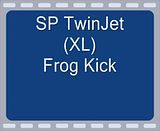- Messages
- 1,066
- Reaction score
- 2
I started out diving Jet Fins in the 70's and switched to Twin Jets when I came back to diving a few years ago. I had heard great things from the LDS about the splits and what I heard sounded good. Faster with less effort, was the claim.
Speed/power is a nice feature, but I found it came at the expense of responsiveness and feedback. After a year of diving the splits, I bought a new pair of Jets and never looked back. The back kick came to me with relative ease after switching to Jets and I deemed the splits incapable of performing a back kick.
In the last three years, I've seen many claims that contradicted my belief that splits were not capable of performing the back kick. I doubted these claims, as I have yet to see it done, so I took my splits out of moth balls to give it a go.
The first test I did was on power. I did this test without SCUBA, to remove some of the variables. The weight belt on the bottom has 29 pounds on it. The XL Twin Jets are close to neutral, while the XL Jet Fins are negative, so there is a couple pound difference between the two.
While it was difficult to kick the belt up with both fins, it seemed the Twin Jets seemed slightly easier to kick up the weight. That slight difference may have been the difference in buoyancy between the two fins, but I would still give the win to the Twin Jets in this test.

When attempting the back kick in splits, the loading stroke is very difficult to avoid generating thrust and the result is forward motion during the loading stroke. With the Jets, the blade slices through the water and produces virtually no thrust during the loading stroke.
Helicopter turns are easy enough in the twins, but they provide virtually no feedback and kick for kick create less thrust than the Jets.


Now, I freely admit I don't dive splits, so I'm hoping someone will post a video showing how great they really are for utility kicks.
Anyone want to buy a set of Twin Jets?
Speed/power is a nice feature, but I found it came at the expense of responsiveness and feedback. After a year of diving the splits, I bought a new pair of Jets and never looked back. The back kick came to me with relative ease after switching to Jets and I deemed the splits incapable of performing a back kick.
In the last three years, I've seen many claims that contradicted my belief that splits were not capable of performing the back kick. I doubted these claims, as I have yet to see it done, so I took my splits out of moth balls to give it a go.
The first test I did was on power. I did this test without SCUBA, to remove some of the variables. The weight belt on the bottom has 29 pounds on it. The XL Twin Jets are close to neutral, while the XL Jet Fins are negative, so there is a couple pound difference between the two.
While it was difficult to kick the belt up with both fins, it seemed the Twin Jets seemed slightly easier to kick up the weight. That slight difference may have been the difference in buoyancy between the two fins, but I would still give the win to the Twin Jets in this test.

When attempting the back kick in splits, the loading stroke is very difficult to avoid generating thrust and the result is forward motion during the loading stroke. With the Jets, the blade slices through the water and produces virtually no thrust during the loading stroke.
Helicopter turns are easy enough in the twins, but they provide virtually no feedback and kick for kick create less thrust than the Jets.


Now, I freely admit I don't dive splits, so I'm hoping someone will post a video showing how great they really are for utility kicks.
Anyone want to buy a set of Twin Jets?



